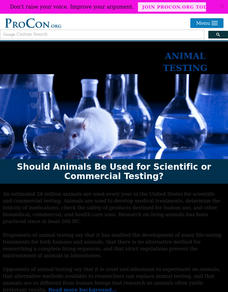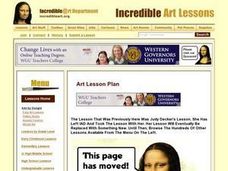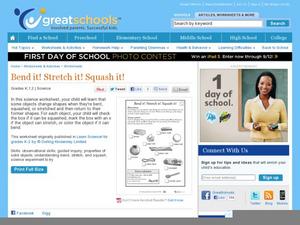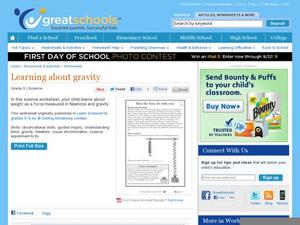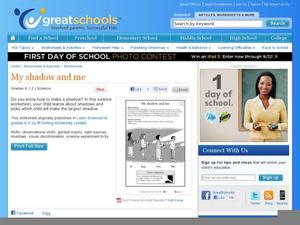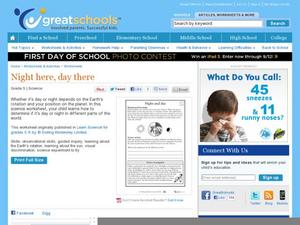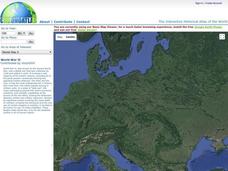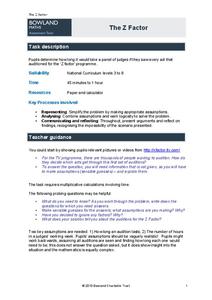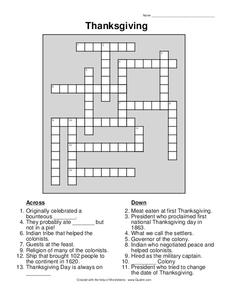DC Vote
One Kid, One Vote
Learn about why the citizens of Washington, D.C. feel unrepresented in Congress with an article about D.C voting rights. Individuals read about the movement toward congressional representation in Washington, D.C., before...
Curated OER
Animal Testing
Animal testing: cruel and inhumane, or innovative and life-saving? Scholars explore the topic and form their own opinions with help from the highly informative website. Pupils read a comprehensive overview of the topic, including...
Curated OER
African Ceramic Portrait Vessel
Middle schoolers create a piece of art inspired by traditional African pieces.
Curated OER
Social Studies Current Event Worksheet
Who, what, when, where, why, and how. This current events worksheet uses the traditional news article format and asks reviewers to record information included in a self-selected, current events article. Class members then use the...
Curated OER
Match the Words
Even if your kids aren't reading yet, they can become familiar with words by identifying two that are the same. Youngsters focus on the word same as they examine eight words and match them to their identical spellings....
DK Publishing
Real-Life Problems: Miles, Pounds, and More
Give young arithmeticians an applicable way to use their addition and subtraction skills with these five word problems. Each one presents a scenario requiring they add or subtract numbers with units (money, distance, weight,...
Curated OER
Bend It! Stretch It! Squash It!
Some items keep their shape no matter what happens! Have your kindergarten class choose which items would stay the same if they were bent, stretched, or squashed. The last activity prompts kids to see what happens when they stretch a...
Curated OER
Getting nosy
A nose knows! Connect animals to their noses with a fun science activity. Animals include elephants, rats, pigs, and even humans. For a science exploration, kindergartners answer questions about what they can smell. A great addition to...
Curated OER
Growing
Growing is part of being a living thing. Kindergartners decide which illustrations represent the life cycle of a living thing, then put a check mark next to the correct pictures. They then examine their own growth on a height chart.
Curated OER
Learning about gravity
Learn how to measure weight with newtons in a science experiment about gravity. After they read a short paragraph about force, fifth graders draw an arrow to indicate which way a spring is being pulled. Next, they survey their family...
Curated OER
My Shadow and Me
Practice making shadows with a kindergarten science experiment. After deciding which picture would represent the biggest shadow, kids use a flashlight to experiment with their own shadows. For extra fun, have kids mark their shadows...
Curated OER
Night Here, Day There
Explore astronomy with a lab sheet for fifth grade scientists. After reading a short explanation about the earth's rotation, they solve a word problem about the differences in times across the world. Next, they make a model of the solar...
Illustrative Mathematics
The Price of Bread
As part of an initiative to strengthen our young adults' financial understanding, this problem explores the cost of bread and minimum wage since the 1930s. Learners are asked to find the percent increase from each year and compare it...
California Polytechnic State University
Australian Geography Unit
At the heart of this resource is a beautifully detailed PowerPoint presentation (provided in PDF form) on the overall physical geography of Australia, basic facts about the country, Aboriginal history, and Australia culture and lifestyle.
BBSRC
Discovering DNA: The Recipe for Life
A pinch of adenine, a dash of thymine and ta-da, you have life! Well, it's not quite that simple, but through this series of activities and experiments young scientists learn about the structure of DNA and how it contains the recipe...
PE Central
Celebrating St. Patrick’s Day with Dance
Erin go bragh! Enliven your St. Patrick's Day celebration by teaching your class members some of the combinations found in traditional Irish step dancing.
Bowland
The Z Factor
Young mathematicians determine the number of hours it would take judges of the "Z Factor" television talent show to watch every act. Participants make estimates and assumptions to solve the problem.
Breaking News English
The Force Awakens Breaks Pre-Sales Ticket Records
May the comprehension skills be with you! Focus on context clues, vocabulary words, and analysis questions with an article about Star Wars: The Force Awakens and its record-breaking ticket sales.
Constitutional Rights Foundation
Educating About Immigration The DREAM Act
Group members role play state legislators, supporters of and opponents to the The DREAM Act (Development, Relief, and Education for Alien Minors). After listening to the arguments put forth for and against the immigration...
Curated OER
Emily Carr: Reading Comprehension
In this reading comprehension worksheet, students read a passage about Emily Carr. Students then attempt to determine the meanings of italicized words from the context in which they were used.
Curated OER
An Arctic Expedition
Young scholars become familiar with the Arctic region and the difficulties of scientific research by designing and developing an expedition to an "unknown" place. They use the library and the Internet in order to do their research. ...
Curated OER
Governance - Grade 8
Eighth graders participate in talking circles. In this self-governance lesson, 8th graders examine human rights from the perspective of Native Americans. Students discuss the Canadian Charter of Rights and Freedoms as well as "Interview:...
Curated OER
Cultural Creation Myths
Students analyze various cultural creation myths, write essays on three different societal stories, and create a play based upon one of those stories in this cross-curricular Theatre project for High School students. Cooperative...
Curated OER
Thanksgiving
In this Thanksgiving instructional activity, students compete the Thanksgiving crossword puzzle. There are 13 clues provided at the bottom of the page for students to use to solve the puzzle.

